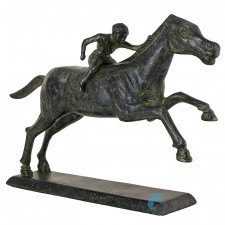Αναβάτης του Αρτεμισίου
Αντίγραφο του αναβάτη του Αρτεμισίου.
Χειροποίητο ορειχάλκινο γλυπτό, με εγγύηση ποιότητας. Παραδοσιακά φτιαγμένο με τη μέθοδο χύτευσης μετάλλου και με οξείδωση παρόμοια με του μουσείου.
Είναι το μεγαλοπρεπέστερο χυτό άγαλμα αλόγου με αναβάτη, που σώζεται από την ελληνική αρχαιότητα. Ανασύρθηκε σε κομμάτια από αρχαίο ναυάγιο και έχει συμπληρωθεί στην ουρά και στο κέντρο του κορμού. Το άλογο αποδίδεται σε έντονο καλπασμό τη στιγμή του αγώνα. Στο δεξιό μηρό του υπάρχει εγχάρακτη μορφή Νίκης, που κρατάει στεφάνι στα ανυψωμένα χέρια της, σφράγισμα σύνηθες σε καθαρόαιμα άλογα στην αρχαιότητα. Η κίνηση και η ανατομία του ζώου αποδίδονται με τρόπο απόλυτα ρεαλιστικό. Ο αναβάτης είναι μικρός σε ηλικία και διαστάσεις, και τα χαρακτηριστικά του προσώπου του δείχνουν ότι πρέπει να ήταν νέγρος. Η μικροσκοπική και άσχημη μορφή του έρχεται σε πλήρη αντίθεση με το υπερήφανο, μεγαλόσωμο ζώο. Στρέφει προς τα αριστερά το κεφάλι του, και τα μαλλιά του είναι ατημέλητα. Φορεί σανδάλια και χιτωνίσκο που ανεμίζει από την ταχύτητα, ενώ στο αριστερό χέρι θα κρατούσε τα ηνία και στο δεξί το μαστίγιο. Το άγαλμα, έργο άγνωστου γλύπτη, πρέπει να ήταν αφιερωμένο σε κάποιο σημαντικό ιερό.
Περισσότερες πληροφορίες εδώ
| Λεπτομέρειες | |
| Ύψος | 12cm |
| Βάρος | 700g |
| Υλικό | Ορειχάλκινο |



